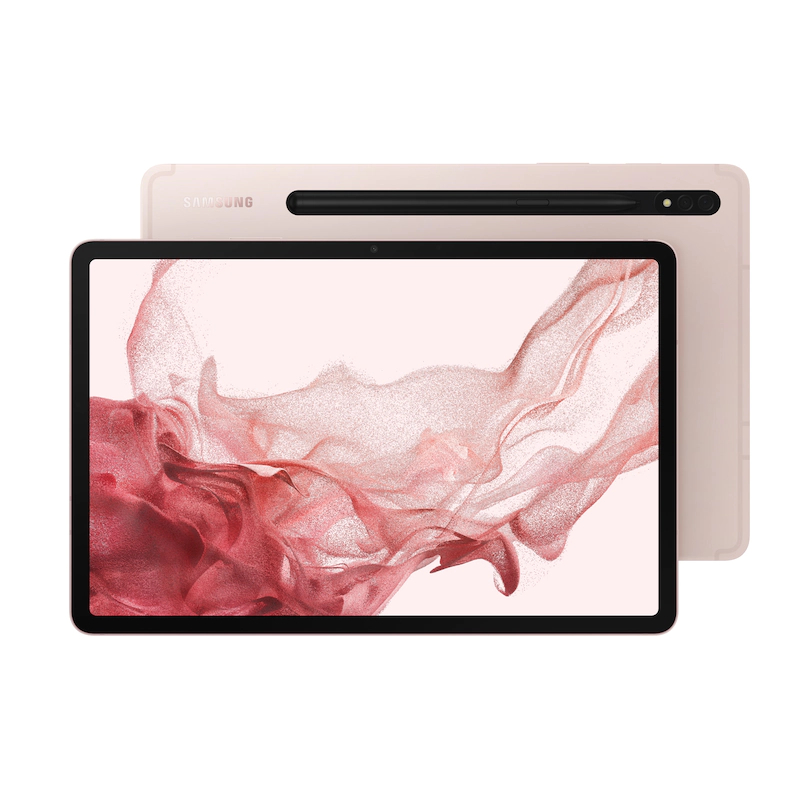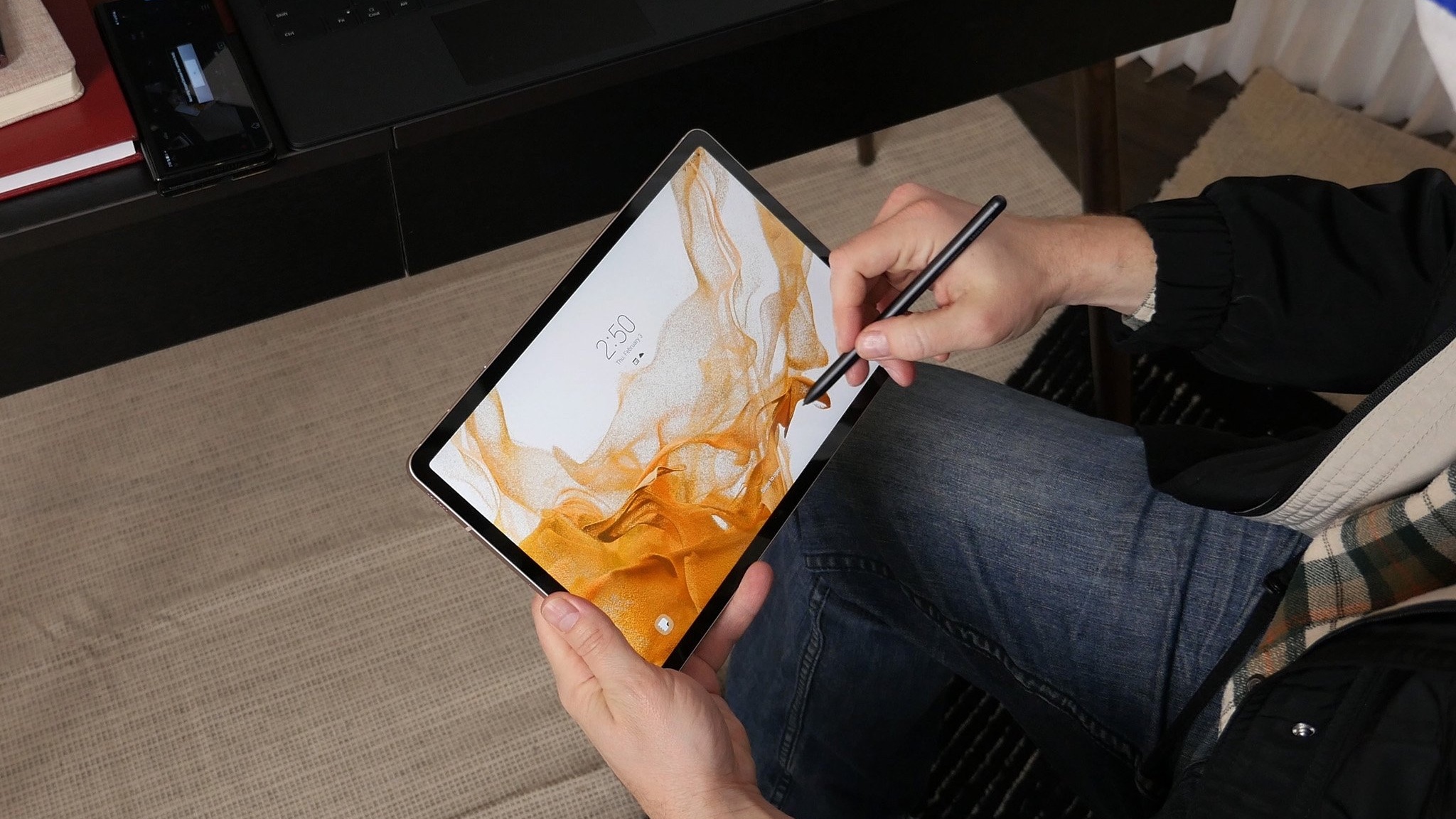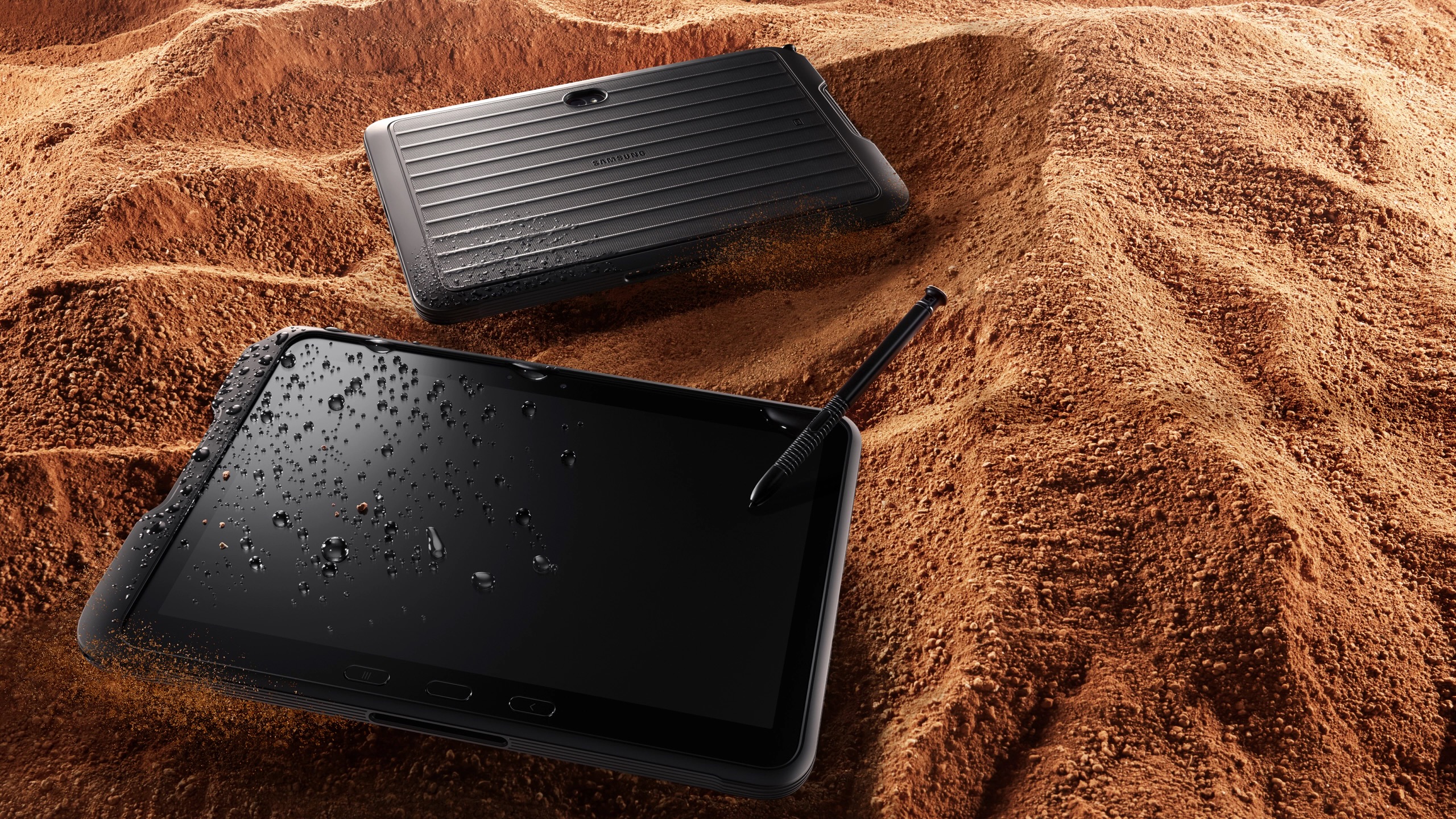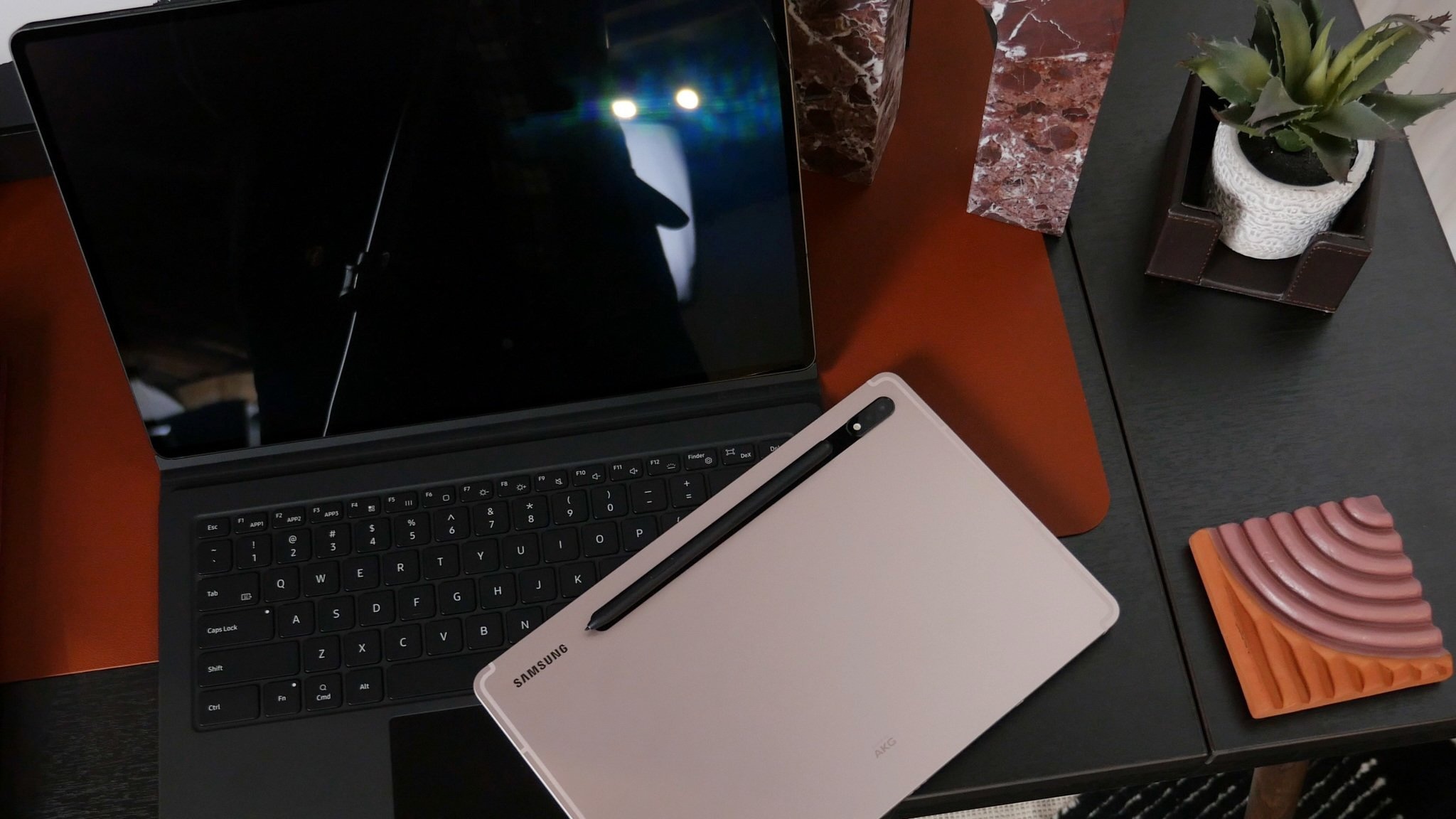Samsung Galaxy Tab Active 4 Pro vs. Tab S8: Ruggedness or power?
Is either Samsung tablet in the other one's league when it comes to ruggedness or performance?

Samsung largely kept the same design as the original 2019 Active Pro, but boosted it with better performance and support for the latest multitasking software. This rugged tablet is marketed towards mobile field workers or outdoorsy types who need protection more than cutting-edge specs.
Pros
- IP68 and MIL-STD-810H protection
- Ships with case and S Pen
- Removable battery & battery-free mode
- Performance boost over original Pro
- Support for 5G, Enterprise features
- Programmable side key
Cons
- Specs downgraded compared to Tab S8
- Heavier, thicker than Tab S8

Whether you buy the smallest Galaxy Tab S8 or upgrade to the Plus or Ultra, you're getting the best Android tablet experience on the market today. It gives you a step up on the Galaxy Tab Active4 Pro in speed, visuals, cameras, audio, and other areas. But it's not necessarily a tablet equipped to handle the great outdoors, and a rugged case will only take you so far.
Pros
- Faster performance
- Quad Dolby Atmos speakers
- Speedier charging
- Higher resolution display w/ 120Hz refresh rate
- Higher-resolution cameras
- Lighter, available in larger sizes
Cons
- No water resistance or fall protection
- Doesn't ship with case
- No 5G support
Samsung's Galaxy Tab Active4 Pro went under the radar when it launched in 2022, especially compared to the high-profile Galaxy Tab S8 launch. But for anyone in the market for a rugged tablet, the newest Active model checks a ton of boxes and is less of a downgrade than Samsung's previous offerings.
Considering the two tablets have very similar price points, the question has to be asked: should you buy the Galaxy Tab Active4 Pro, or just slap a case and screen protector on the Galaxy Tab S8 so you don't have to accept any trade-offs? In this Samsung Galaxy Tab Active4 Pro vs. Tab S8 guide, we'll try to answer that question.
Samsung Galaxy Tab Active4 Pro vs. Tab S8: Design and display

We'll talk about ruggedness (or lack thereof) in a later section; let's start by talking about how it feels to hold these two devices. The Galaxy Tab Active4 Pro measures about 0.4 inches or 10mm thick, significantly beefier than most tablets — let alone the 0.25-inch Galaxy Tab S8.
As we said in our Galaxy Tab S8 hands-on, the tablet is "reasonably comfortable to hold for a good bit of time," with smoothly chamfered corners and bezels just wide enough to leave room for your fingers.
Its thin, aluminum design actually works against it a bit, compared to thicker and more rounded tablets like the Pixel Tablet; its thinness means you're going to have more of a claw grip, with pressure on your fingertips. But compared to the larger Tab S8+ and Tab S8 Ultra, it's certainly the only model that we'd consider "portable."
Compared to that, the ultra-thick Galaxy Tab Active4 Pro weighs much more and is better suited for sitting docked somewhere. But it does, at least, give you plenty of room to grip, especially when you attach the case. The actual display bezels aren't that different from the Tab S8 bezels, but the case gives your hands more room to comfortably curl and a ridged back to rest your fingers against. Though, of course, you can buy a rugged case for the Tab S8 and get the same effect.
One unique feature on the Galaxy Tab Active4 Pro is a programmable side key that you can press or hold to trigger two separate shortcuts, aside from whatever shortcuts you add to the power button.
Get the latest news from Android Central, your trusted companion in the world of Android

As for the display, the Galaxy Tab S8 has the obvious edge here. Both have standard LCDs — a step down from the rich-color AMOLED displays of the Tab S8+ and Ultra — but the Tab S8 has a solid 50 pixels per inch more than the Active4 Pro, as well as an ultra-smooth 120Hz refresh rate.
In defense of the Galaxy Tab Active4 Pro, 1920 x 1200 is a perfectly respectable resolution for a 10-inch tablet, and beats many of the best cheap Android tablets in this category. It also hits 550 nits to make it better suited for outdoor use; Samsung didn't specify a brightness score for the Tab S8, but our parent company's Future Labs testing revealed an average of 463.
Still, the Galaxy Tab S8 is the clear winner for both casual streaming and everyday productivity, since 120Hz scrolling (and the faster processor) makes a major difference in avoiding a stuttery experience.
Both of these Galaxy tablets displays support the S Pen and come with the stylus out of the box. We know that the Galaxy Tab S8 has an impressively low 6.2ms latency between touch and reaction; Samsung didn't specify the latency for the Galaxy Tab Active4 Pro, but its marketing materials say "near-zero latency" and that it reduced the latency compared to the original Active Pro, so there probably isn't a noticeable difference.
Lastly, only the Galaxy Tab S8 has color options besides black. Though to be fair, its silver and pink gold finishes aren't the flashiest options out there.
Samsung Galaxy Tab Active4 Pro vs. Tab S8: Hardware
| Category | Samsung Galaxy Tab Active4 Pro | Samsung Galaxy Tab S8 |
|---|---|---|
| Chipset | Snapdragon 778G | Snapdragon 8 Gen 1 |
| Display | 10.1-inch TFT LCD (60Hz), 1920 x 1200 | 11-inch TFT LCD (120Hz), 2560 x 1600 |
| Memory | 4GB or 6GB | 8GB |
| Storage | 64GB or 128GB | 128GB or 256GB |
| Expandable storage | Shared microSD slot (up to 1TB) | Dedicated microSD slot (up to 1TB) |
| Rear Camera | 13MP AF | 13MP AF + 6MP UW |
| Front Camera | 8MP | 12MP UW |
| Battery | 7,600mAh (removable) | 8,000mAh (fixed) |
| Charging | 15W USB-C | 45W Fast Charging (USB-C) |
| Audio | Stereo speakers, 3.5mm port | Quad Speakers + Dolby Atmos |
| Authentication | In-display fingerprint sensor | Fingerprint on power button |
| Connectivity | WiFi 6, Bluetooth 5.2 | WiFi 6E (6GHz), Bluetooth 5.2 |
| Protection | Gorilla Glass 5 | Gorilla Glass 5, IP68, MIL-STD-810H compliant |
| Stylus | S Pen included | S Pen included w/ 6.2ms latency |
| Dimensions | 242.9 x 170.2 x 10.2mm | 253.8 x 165.3 x 6.3mm |
| Weight | 674g; 824g with case | 503g |
| Colors | Black | Graphite, Silver, Pink Gold |
| Price | $760-$820 | $700-$780 |
The key upgrade between the original Galaxy Tab Active Pro and Active4 Pro is the switch from the Snapdragon 670 to 778G. For context, the most famous Snapdragon 670 phone was the Pixel 3a, which Google optimized with its AI tricks in 2019 but faded in performance fairly quickly.
The Snapdragon 778G can be found in the Nothing Phone (1), Xiaomi 11 Lite 5G, Poco X5 Pro, all relatively recent phones we gave quite positive reviews. As our editor Harish Jonnalagadda put it, the 778G is a "stalwart" chip for the mid-range category that "delivers good performance for daily use and occasional gaming."
To be clear, though, that mainly applies to phones with 6–8GB of RAM. The 4GB/64GB base model of the Galaxy Tab Active4 Pro is probably going to underperform compared to what you'd want in a modern tablet; we recommend shelling out the extra $60 for the 6GB/128GB variant.
If you plan to use the Active4 Pro's 5G capabilities, that's another reason to upgrade. It has a single slot that you can use for a 5G chip or a microSD card, not both; and 64GB just isn't enough storage these days, unless you really don't plan to download that many apps. 128GB is much more manageable.

By contrast, the Galaxy Tab S8 has the Snapdragon 8 Gen 1, a flagship chip that runs laps around the Snapdragon 778G in benchmarks, and 8GB of RAM by default.
Despite the fact that the 8 Gen 1 ended up attracting controversy for its tendency to run hot, it's still a flagship chip facing off against a mid-range chip. If you want to use your tablet for playing the best premium Android games that demand high GPU performance, you'll want the Galaxy Tab S8 — both for faster speeds and smoother refresh rates.
The Galaxy Tab S8 also wins for audio performance. In our Tab S8+ review, we found that the "sound quality stays rich and clear no matter how you orient it or how high you pump the volume," and the Plus has the same Dolby Atmos-tuned speakers as the smaller model. For comparison, the Active4 Pro stereo speakers aren't going to have the same richness or bass power; but you do at least have a 3.5mm headphone jack, something the Galaxy Tab S8 lacks.
For battery longevity, the Galaxy Tab S8 series lasted about a dozen hours of active use in our tests, making it one of the best in that category. The Galaxy Tab Active4 Pro battery is only slightly smaller, and the smaller 60Hz display and quite efficient 778G chip should help the rugged tablet last just as long.
The downside of the Active4 Pro is its 15W charging speed. Refilling a 7,600mAh battery with a 15W max will probably take about 3 hours. But unlike most tablets, you can actually take off the back panel and remove the battery entirely; so if necessary, you could buy a replacement battery and swap it in fully charged, giving you time to recharge the original battery.
Samsung Galaxy Tab Active4 Pro vs. Tab S8: Ruggedness and software

Both the Galaxy Tab S8 and Galaxy Tab Active4 Pro have Gorilla Glass 5 protection. And Samsung claimed when the Tab S8 launched that its new Armor Aluminum frame was 30% more scratch-resistant and 40% less prone to bending than the Galaxy Tab S7, whereas we believe the Active4 Pro uses a different, more rugged material.
Now, let's focus on all of the unique outdoor-focused features that the Galaxy Tab Active4 Pro has, starting with its IP68 water resistance rating for both the tablet and the S Pen. Samsung says you can submerge it in "up to 5 feet of water for up to 30 minutes" without any problem.
While we've heard the upcoming Galaxy Tab S9 may have water resistance, this is still an incredibly rare feature that a certain type of user will appreciate.
As we mentioned before, the Galaxy Tab Active4 Pro battery can be removed. Intriguingly, it has something called "No Battery Mode," which lets you use the tablet "continuously at a kiosk or in a vehicle without battery, while also preventing depleted battery health, even in high-temperature environments." In other words, keeping it constantly plugged in won't do damage to its battery life capacity.

In terms of durability, the Active4 Pro is MIL-STD-810H compliant. What does that mean in practice? Samsung says it survived being "dropped 26 times from 5 feet onto plywood," can withstand temperatures from −40º F to 176º F, and can ignore "harsh rain, salt spray, and solar radiation." You can even take it up to 15,000 feet if that's the kind of life you lead.
Otherwise, aside from it being one of the best-rugged tablets out there, the Galaxy Tab Active4 Pro has specific software and tools that make it geared for outdoor and enterprise use.
It has 5G support, something the Galaxy Tab S8 lacks (Samsung made 5G a Tab S8+ exclusive for some reason). It supports CBRS radio frequencies for active outdoor jobs, and both barcode scanning and mobile Point of Service (mPOS) terminal tech for businesses.
Otherwise, both tablets currently support One UI 5.1 based on Android 13. We know that the Galaxy Tab S8 will get three more updates to Android 16, but we don't know how many updates the Galaxy Tab Active4 Pro will get. It's also fair to note that the Galaxy Tab S8 will receive updates faster as a flagship device.
Samsung Galaxy Tab Active4 Pro vs. Tab S8: Which should you buy?

Even though we generally prefer the Plus and Ultra for various reasons, the Galaxy Tab S8 still belongs in the conversation of the best Android tablets due to its relatively compact size and more affordable price tag. Until the Tab S9 arrives, it has very few competitors.
The Galaxy Tab Active4 Pro, meanwhile, has very few competitors outside of Samsung in the rugged category. Most other major Android brands don't have a competing rugged model, so your only alternatives are from less well-known brands or switch to rugged Windows tablets instead of Android and DeX.
If you want, you can rely on a Galaxy Tab S8 case and a screen protector for a slight durability upgrade...but it won't close the gap on the Active4 Pro. A case will make it more shockproof, but you can't use a case to keep out water, humidity, extreme temperatures, and other environmental dangers. So it really depends on how rugged you need your tablet to be.
Generally speaking, the Galaxy Tab Active4 Pro isn't as much of a step down in performance as past Samsung rugged tablets, making it more palatable.

Choose the Galaxy Tab Active4 Pro if you specifically need a tablet for enterprise purposes or taking it on intense outdoor excursions — or if you need a replaceable battery. Don't choose it if you want cutting-edge performance.

Choose the Galaxy Tab S8 if you want an indoor tablet that trumps the competition in nearly every category. Don't choose it if you want something built to withstand anything you throw at it, from water to heavy falls.

Michael is Android Central's resident expert on wearables and fitness. Before joining Android Central, he freelanced for years at Techradar, Wareable, Windows Central, and Digital Trends. Channeling his love of running, he established himself as an expert on fitness watches, testing and reviewing models from Garmin, Fitbit, Samsung, Apple, COROS, Polar, Amazfit, Suunto, and more.
